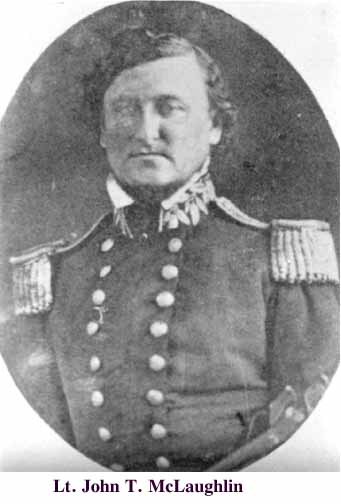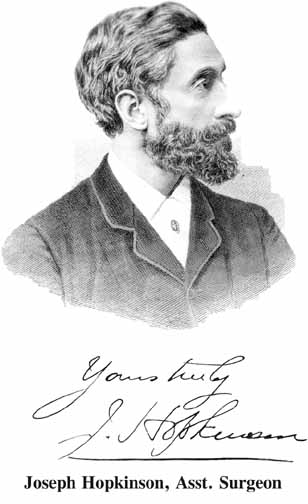Details of Indian Key history continued LT. JOHN T. MCLAUGHLIN
and the FLORIDA SQUADRON
This page by Jerry WilkinsonFor an introduction, John Thomas McLaughlin was born in Baltimore, Maryland on April 7, 1812 and entered the U.S. Navy as a Midshipman in 1827. From 1829 to 1831 he served as a Midshipman on the sloop ERIE and then to 1833 on the sloop BOSTON when he was promoted to Passed Midshipman. In 1835 his duty was coastal survey.
Now for some specifics. From the National Archives, "The Navy Department ordered the Navy to cooperate with the land forces May 25, 1836, on and from which date to the close of the war August 14, 1842, vessels on the Home and West India Station will be regarded as cooperating with the land forces in the prosecution of the Florida War. The duration of the war was from December 28, 1835 to August 14, 1842."
Engaging a non maritime foe was a completely new role for the Navy. There were no enemy cruisers, merchant ships or even pirates or harbors to attack. Lt. McLaughlin was entering a new era of naval history.
During the Florida War, also known as the Second Seminole War, the inhabitants of Key West considered themselves dangerously exposed to the Indians and in various requests asked for the assignment of a "cutter." In 1836, naval operations in Florida were directed from Pensacola by a Commodore Alexander J. Dallas. Navy headquarters had been moved there from Key West after the court martial of David Porter presumably because of the yellow fever in Key West. Dallas dispatched the Revenue Cutter DEXTER which arrived at Indian Key on June 24, 1836. On July 7, 1836, the schooner MOTTO under Lt. Leib and with 20 marines were dispatched, however both ships returned to Pensacola by years end.
In June, 1837, the inhabitants of Indian Key and the vicinity petitioned the Secretary of the Treasury, Levi Woodbury, for a properly manned cutter to be stationed at or near Indian Key. This was partially in response to the death of Captain Whalton and one of his men on north Key Largo from the lightship at Carysfort Reef. The petition added that they had spent upwards to $9,000 in protecting themselves. Presumably much of this was the cost of Jacob Housman operating his Company B, 10th Regiment of the Florida Militia formed on January 1, 1836.
Elsewhere, on February 8, 1837, Indians attacked Camp Monroe (Fort Mellon) and Captain Mellon was killed and Midshipman J.T. McLaughlin "received a ball in his breast" and recovered after six months. This was new for the Navy, that is combat on land with the Army.
McLaughlin was commissioned to Lt. in 1838 and commanded a small detachment to become also known as the "Mosquito Fleet" (A name first given to Commodore Porter's anti-pirate squadron.) and the "Florida Expedition."
Senate Report #101 of the 29th Congress dated January 30, 1847 stated: "Some time in 1838 Capt. Mayo and Lt. McLaughlin, with a view of cooperating with the Florida War, were cruising the neighborhood of Indian Key and for a time made use of the island as a naval station, for purposes of deposits and as a hospital In September, 1839 the yellow fever broke out with such violence as to render it necessary to change the station. The sick and the naval stores were removed to Tea Table Key, a small island about a mile distant from Indian Key."
In 1838, McLaughlin commanded the Schooner WAVE with a crew of 40 able seamen which had to be taken in for repair. In November, 1839, he was put in command of the newly constructed schooner FLIRT. On December 2, 1839, then Secretary of the Navy, J.K. Paulding in a rather lengthy letter, ordered Lt. McLaughlin ". ..to a point of the coast of Florida, as your knowledge and experience in that quarter furnish yourself with a sufficient number of flat bottomed boats and in addition to these procure a like sufficiency of long plantation canoes ...By this means the Department cannot but hope you will be able to penetrate the Everglades further than any white men, surprise and capture the Indian women and children and thus end the war which has cost so many millions .... Commander Mayo has been ordered to return to the north with the side wheeler steamship "Poinsett" and directed to leave his barges at Tea Table Key for your use should you require them. In addition to these boats, you are authorized, if the opportunity offers to procure a couple or more of Spanish bloodhounds, not to hunt down and destroy the Indians, but to be employed in scouring the banks of the streams and inlets, into which you may penetrate in order to guard against arbuscades (ambush) . ...you will act as Purser of the FLINT and OTSEGO, having no officer of that class at its disposal..." This more or less put McLaughlin in charge of all the naval forces in the Dade Monroe county areas. Also note that the ship's captain received his orders directly from the Secretary of the Navy.
There are later references to the Tea Table Key military installation being called Fort Paulding, probably after Secretary of the Navy J. K. Paulding. No official communications appear to have used this name designation.
It appears that Commander Mayo was sick with yellow fever, on what was referred to as a hospital for sick U. S. soldiers and sailors on Indian Key, when Lt. McLaughlin returned to Indian Key and was ordered north with Steamer POINSETT. It was then that McLaughlin set up naval operations on Tea Table Key.
In hindsight, we know that the Indian Key raid occurred on August 7, 1840. Three days prior, on August 4, 1840, Lt. McLaughlin wrote from Key Biscayne to Navy Secretary Paulding: "Lt. Rogers (son of Commodore Rogers) in the WAVE, sailed today with 18 canoes for Cape Romano (around Naples), on the western coast, touching on his passage at Tea Table Key for provisions and to take off all the people capable of quitting the hospital, for another attempt to cross the Everglades from that vicinity ...."
McLaughlin suspected the Spanish Indians were up to something and was trying to get a man, known as Negro John imprisoned by the Army at Fort Dallas (Miami), to be released to locate the Indians. Being unsuccessful he sent Lt. Rogers with the above dispatch to the southwest coast of Florida to await his arrival.
The Indian raid of Indian Key occurred shortly after Lt. Rogers departed Tea Table Key. Small as it was, Tea Table Key was a hospital and training center. Midshipman Murray and five seamen were left to take care of the sick on Tea Table Key. Indian Key was now relatively unprotected except for its residents. It is generally believed that the Indians were in the area waiting for something like this to happen and almost immediately seized the opportunity.
After the attack, Midshipman Francis Key Murray wrote his rendition to Lt. McLaughlin at Key Biscayne and I quote in its entirety: "I have the honor to report that Indian Key was last night taken by the Indians, of which fact I was appraised from the (schooner) MEDIUM at daylight this morning, our force here considered of five men, with whom joined to seven or eight of the sick, who volunteered readily, but were too weak to be of much service. I started for the key; at first, with the intention of landing, which however was opposed by the enemy who had taken refuge in every house, and opened a heavy fire which fell thick around us, striking our boats, and wounding one man severely and dangerously in the thigh. They appeared in great numbers on the beach, yelling and firing, which firings we returned with three discharges of our four pounders (cannons), in the barges. At the third discharge, being obliged to fire them athwartship (sideways not bow to stern), our guns rebounded overboard, being deprived of the means of cutting off their retreat, I returned to Tea Table Key, to make preparations for the attack which I think more than probable it is their intention to make upon us, being assured, that our amount of force, and means, rendered us no assistance to the inhabitants of Indian Key, if any survived, which is not to be supposed.
"The families of Messers Housman and two seamen have alone escaped. Signature. P/S. The Indians force at the lowest estimate judging from the numbers of canoes is fifty or sixty, I am obliged to write in great haste. The Indians used the long guns on the key (Housman's cannons) firing them at us repeatedly with good aim."
Now back to Cape Romano on Florida's west coast; Lt. Rogers wrote in his August 9, 1840 report, "Immediately on its receipt (A dispatch from Lt. McLaughlin after he had receive Murray's.) I sent for canoes and the Marines who were on shore guarding them; owing however to the wind, the high seas and the distance, it was eight o'clock in the morning before they got on board, having been pulling (rowing) all night. At nine o'clock I got underweight for Indian Key, but did not arrive at Cape Sable until the morning of the 11th having light airs and calms. Thence, I started immediately in the canoe with sixty officers and men for Indian Key, where I arrived the next morning (12 August) at nine o'clock, having pulled nearly 24 hours without stopping, except half an hour for meals."
Housman and McLaughlin wasted no time after the raid and from the National Archives: "This instrument testifies to an agreement between the undersigned contracting parties, the first named John T. McLaughlin in the behalf of the United States, and the second Jacob Housman of Indian Key. Jacob Housman of Indian Key, yields all right and claim to his property and possession on Indian Key to John T. McLaughlin for the United States, to be used as a military outpost during the continuance of the Florida War, or for as long a period as the government of the United States may think proper to occupy it during the war, reserving to himself for his personal uses only that portion to be by him enclosed which shall be hereafter defined by the contracting parties. Signed this 9th day of August, 1840 at Indian Key. (signed) John T. McLaughlin Lt. Comdt. Flirt; Jacob Housman."
McLaughlin advised Secretary Paulding on August 11 that he ordered the transfer from Tea Table Key claiming Indian Key had an abundance of water, good wharves, storage space and that he would not have to divide his force to defend both islands.
Key West then requested a garrison for which McLaughlin sent 30 men and two officers and advising that its citizens are the natural protectors and guardians of the cities welfare and the citizens capable of bearing arms embody their own defense.
All this time McLaughlin operated a General Hospital of the Squadron on Indian Key. Drs. Hopkinson and John Hastings were the two medical officers in charge. There were two others. In a signed but undated list he listed 23 officers and seamen and 17 marines who died while under his command. The listed ended with the number of those belonging to the Squadron, who died elsewhere of diseases contracted in Florida, cannot be ascertained. From 125 to 150 sick men were sent to the North for treatment, their cases being looked upon, if not hopeless, as quite incurable in Florida. The General Hospital of the Squadron was established on Indian Key. All deaths on the Key were Hospital cases.
The war ended in 1842 and Lt. McLaughlin ended his command of the Florida Expedition. It is reported by a letter of Captain M. W. Arnold dated June 23, 1864 that this unit at one time was as large as 622 men with 7 small vessels, 2 barges, 140 canoes, 68 officers, 130 attached Marines and other personnel.
As in many cases, there is now time for scrutiny of many past operations. I am not sure what triggered the investigation of McLaughlin, but I suspect it was the court martial of one of his officers, a Marine Lt. Robert Tansill.
Anyway, Congress finally directed The Navy to conduct a full investigation March 3, 1845. A lengthy Navy investigation followed in which the Lt. had a book of allegations thrown at him while on leave status. For example, a Private John Shaffer accidentally fired his gun and Lt. McLaughlin had him flogged with 60 lashes at one time. There were more floggings charged. He had purchased his canoes for $226 apiece where the Army paid $20 apiece for theirs. He purchased doubloons at a cheaper rate than what he counted when paying his men. He constructed buildings on Indian Key for his personal use. He was in collusion with George Center who operated the only store on Indian Key after the attack. The entire Navy spent $30,000 in 1841 for all its hospitals and McLaughlin spent $16,245.26 of it on the Indian Key hospital alone ($10,605.52 for eatables and drinkables.) He considered himself "Captain in Command." The list went on.
On the ten specific charges, the Naval Court of Inquiry did say that he had no right to call himself Captain, paid too much for the canoes, however the remainder of charges were vague, not enough evidence, no certain data and he may have enriched himself, but not specifically.
From naval records, Lt. McLaughlin was ordered to New Orleans to await orders on November 20, 1846 and on the 23rd ordered to command the Steamer HUNTER. The National Archives show that John J. (sic) McLaughlin was the owner of the HUNTER built in Pittsburgh and no evidence of its ultimate fate.
Lt. McLaughlin died at age 36 on July 8, 1847 in line of duty of a service induced disease with an accumulated Sea Service of 10 years and five months with total military service of 19 years and one month. His wife Salvador Meade and children Salvadora and Margaret received a Navy pension.The End
Click HERE for tour to Biography of Richard Firzpatrick
Click HERE to return to the Indian Key Home page
